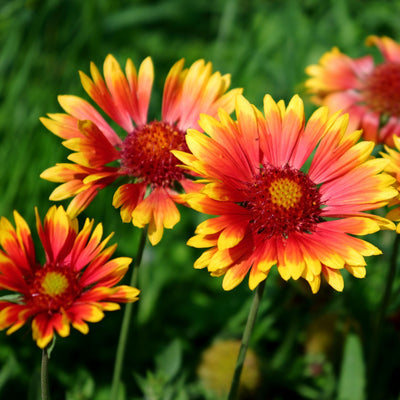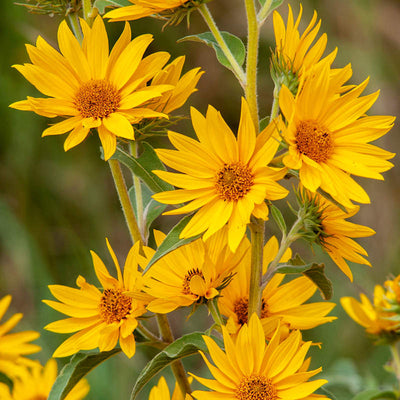
Frost-Proof Perennials
Share
A Gardener's Guide to Resilient Plants
Gardening enthusiasts often face the challenge of selecting plants that can withstand varying weather conditions, especially in frost-prone regions. Frost-proof perennials answer this problem, offering beauty and resilience year after year. In this article, we will explore several frost-proof perennials, including the vibrant blanket flowers, elegant hostas, delicate lily of the valley, hardy purple coneflowers, colorful creeping phlox, and versatile yarrow. These plants survive frost and thrive, adding charm and vibrancy to your garden.
Blanket Flowers (Gaillardia)
Blanket flowers, scientifically known as Gaillardia, are native to North and South America and are cherished for their striking, daisy-like blooms. These perennials are exceptionally frost-resistant, ideal for gardens in colder regions. Blanket flowers come in various colors, including red, yellow, and orange shades, often with vibrant bi-colored petals. Their serrated petals resemble the patterns of Native American blankets, giving them their name. These hardy perennials prefer well-drained soil and total sun exposure, making them low-maintenance additions to your garden. Blanket flowers attract pollinators like bees and butterflies, adding a lively touch to your outdoor space. Deadheading, spent blooms encourage continuous flowering throughout the growing season, ensuring a colorful display even in the face of frosty temperatures.
Hostas (Hosta spp.)
Hostas are renowned for their lush foliage and elegant, shade-loving nature. These perennials are excellent for gardens in frost-prone areas because they can endure chilly temperatures and even light frost without significant damage. Hostas are prized for their captivating foliage, which varies in shades of green, blue, and variegated patterns. To maximize their frost resistance, plant hostas in well-drained soil and provide them with partial to full shade. Their low-maintenance nature and deer resistance make them popular choices for gardeners. Hostas also produce lovely, bell-shaped flowers in the summer, adding charm to your garden.
Lily of the Valley (Convallaria majalis)
The delicate fragrant lily of the valley, or Convallaria majalis, is a classic choice for frost-proof perennials. This plant is celebrated for its charming, bell-shaped white flowers that bloom in spring. Despite its delicate appearance, the lily of the valley is surprisingly resilient to frost and cold temperatures. These perennials thrive in partial to full shade and prefer well-draining, humus-rich soil. They form spreading colonies, creating a lush, fragrant carpet in your garden. The Lily of the Valley symbolizes purity. It is often used in floral arrangements due to its enchanting fragrance and timeless beauty.
Purple Coneflowers (Echinacea purpurea)
Purple coneflowers, scientifically known as Echinacea purpurea, are robust and enduring perennials, making them a reliable choice for frost-prone gardens. Their vibrant, daisy-like flowers come in shades of pink, purple, and white, attracting pollinators like bees and butterflies throughout the growing season. Plant purple coneflowers in well-drained soil, giving them full sun to light shade. These perennials are frost-resistant and drought-tolerant, making them an excellent addition to low-maintenance landscapes. They are also cherished for their medicinal properties, as they are believed to boost the immune system.
Creeping Phlox (Phlox subulata)
Creeping phlox, or Phlox subulata, is an incredibly cold-tolerant ground-covering perennial. This low-growing plant forms dense mats of colorful, star-shaped flowers in shades of pink, purple, blue, and white. Its evergreen foliage provides year-round interest in your garden. To ensure the best performance in frost-prone areas, plant creeping phlox in well-drained soil with full sun exposure. These perennials are perfect for rock gardens, slopes, or as an edging plant. Their ability to withstand cold temperatures while maintaining vibrant blooms makes them valuable to any frost-proof garden.
Yarrow (Achillea millefolium)
Yarrow, scientifically known as Achillea millefolium, is a versatile perennial known for its fern-like foliage and flat clusters of tiny flowers in various colors, including white, yellow, pink, and red. This hardy plant thrives in cold climates and is well-suited for frost-resistant gardens. Plant yarrow in well-drained soil with full sun exposure to promote healthy growth. Yarrow is not only frost-proof but also drought-tolerant, making it an ideal choice for xeriscaping. Its feathery foliage and unique, long-lasting flowers add texture and color to your garden, attracting beneficial insects like ladybugs and hoverflies.
Adaptability
Frost-proof perennials are essential for gardeners in regions with cold winters, offering a resilient and beautiful way to enhance their outdoor spaces. Blanket flowers, hostas, lily of the valley, purple coneflowers, creeping phlox, and yarrow are excellent choices for those looking to create gardens that withstand frost while providing vibrant and colorful displays throughout the year. With proper care and placement, these perennials will thrive and contribute to the long-lasting beauty of your garden, even in the face of frosty weather.
Frost-proof perennials are a testament to nature's ability to adapt and endure in the harshest conditions. These hardy plants survive cold temperatures and often thrive, becoming beacons of color and life when the world around them seems frozen. They are the resilient warriors of the garden, offering hope and beauty even in the depths of winter. The key to their success lies in their adaptability, whether it's the bold and vivid blooms of blanket flowers, the lush foliage of hostas, the fragrance of lily of the valley, the hardy charm of purple coneflowers, the ground-covering beauty of creeping phlox, or the versatility of yarrow. These frost-proof perennials are a gardener's dream, providing enduring beauty and a touch of nature's strength to your outdoor spaces.








